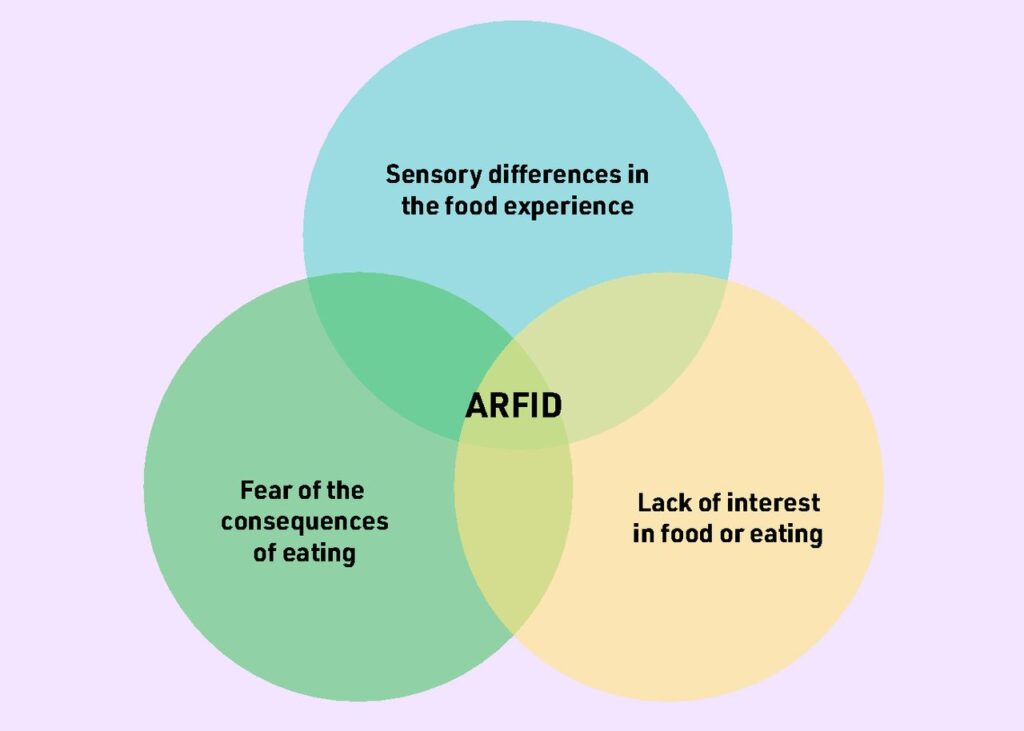Avoidant/Restrictive Food Intake Disorder, or ARFID, is a condition where a child avoids or limits food in a way that harms their health. Many people think it’s just picky eating. But ARFID is more serious. It affects how a child grows, feels, and lives every day.
In this article, we will explain what ARFID is, how to spot it, what causes it, and how to treat it.
What Is ARFID?

ARFID stands for Avoidant/Restrictive Food Intake Disorder. Doctors use this name to describe people—often children—who don’t eat enough variety or quantity of food.
It was added to the DSM-5 (a book that helps doctors diagnose mental health conditions) in 2013. Later, in 2018, ARFID was included in the ICD-11, which is used around the world to classify diseases.
Unlike anorexia nervosa, ARFID is not about fear of gaining weight. Children with ARFID are not worried about body image. They avoid food for other reasons.
ARFID vs. Picky Eating
At first, ARFID may look like picky eating. Many kids refuse to eat broccoli or only want pasta. But most picky eaters improve as they grow.
ARFID is different. Children with ARFID may:
- Eat only a few very specific foods
- Refuse entire food groups
- Avoid eating outside of home
- Feel anxious when new foods are served
These behaviors are not just habits. Over time, they can lead to:
- Weight loss or slow growth
- Vitamin and mineral deficiencies
- Reliance on supplements or feeding tubes
- Problems at school or with friends
If you’re unsure whether your child is just a picky eater, you can visit this helpful resource.
Main Signs of ARFID
To diagnose ARFID, doctors look for signs such as:
- Very limited food intake
- Refusal to eat foods with certain smells, textures, or colors
- No interest in food or eating
- Anxiety about eating because of fear (choking, vomiting, etc.)
These habits must also lead to health or emotional problems. If they don’t, the child may simply be a picky eater.
Importantly, ARFID is not caused by cultural or religious food rules. And it is not related to wanting to lose weight.
The Three Types of ARFID
Experts have found three main reasons why children avoid food. Each child may show signs of one, two, or all three types.
1. Low Interest in Food
Some children don’t seem hungry. They may forget to eat or say they’re full quickly. These children often eat very little. Emotional struggles like anxiety or sadness may also reduce appetite.
2. Sensory Sensitivities
Some kids are sensitive to the look, smell, or texture of food. They may:
- Avoid mushy or sticky foods
- Refuse anything green
- Only eat crunchy items
This type of ARFID is common in children with autism or sensory processing problems.
3. Fear of Harm
In this type, children fear that eating will cause harm. They may worry about:
- Choking
- Vomiting
- Allergic reactions
- Stomach pain
These fears often start after a bad food experience. For example, if a child choked once, they may now avoid solid foods.
Who Gets ARFID?
ARFID usually starts in young children, but it can also begin in teenagers or even adults.
Risk factors include:
- Autism or other developmental conditions
- Anxiety or past trauma
- Food allergies
- Stomach or digestive issues
However, some children develop ARFID with no clear cause.
What Causes ARFID?
The exact cause of ARFID is still unknown. But many experts agree that it comes from a mix of:
- Biology (such as low appetite or high sensitivity to taste)
- Psychology (like anxiety or fear)
- Life experiences (like choking, getting sick, or pressure to eat)
Dr. Thomas created a three-part model in 2017. He said that children may have:
- Low interest in food
- Emotional sensitivity
- A bad food event (like choking or vomiting)
This model helps explain ARFID but still needs more research. You can read about it here.
How ARFID Is Diagnosed
Diagnosing ARFID can be tricky. Doctors often use a mix of:
- Interviews with the child and parents
- Growth charts
- Food journals
- Questionnaires and checklists
There is no single test for ARFID yet. Still, early diagnosis helps prevent serious health issues later.
How ARFID Is Treated
There is no one simple cure for ARFID. But therapy, family support, and nutrition help can improve the situation.
1. CBT-AR (Cognitive Behavioral Therapy for ARFID)
This treatment was created by Thomas and Eddy in 2018. It helps kids slowly face food fears and try new foods. It includes:
- Step-by-step exposure to feared foods
- Positive rewards
- Relaxation and breathing techniques
Learn more about CBT-AR.

2. CBT-E (Enhanced Cognitive Behavioral Therapy)
CBT-E is another approach. It helps children who want control over their food or fear what food will do to them. Therapists use this method to:
- Reduce fear around eating
- Help kids understand their thoughts
- Build flexible eating habits
More about CBT-E is available here.
3. Family Involvement
Since ARFID often begins in childhood, family support is key. Parents learn how to:
- Stay calm at mealtimes
- Offer foods without pressure
- Use gentle encouragement
- Work with therapists and dietitians
4. Nutrition Support
Some children need:
- Oral supplements
- Feeding therapy
- Short-term tube feeding
A dietitian can help create a balanced plan to slowly reintroduce foods.
What Happens Over Time?
With early help, many children with ARFID can:
- Gain weight
- Improve their health
- Feel less afraid of food
- Eat a wider variety of meals
Recovery takes time. Some children improve in a few months. Others may need support for years.
Parents should stay patient and work closely with health professionals.
Why Early Action Matters
If left untreated, ARFID can lead to:
- Long-term growth problems
- Learning delays
- Social isolation
- Ongoing mental health issues
That’s why it’s important to act early. If your child refuses food or loses weight, speak to your doctor.
Helpful Resources
To learn more or find support, visit:
- NEDA ARFID Page
- Autism Speaks on Sensory Issues
- Anxiety Canada
- National Institute of Mental Health – Eating Disorders
Final Thoughts
ARFID is more than just a phase or a food habit. It’s a medical condition that needs understanding and care. With support from families, doctors, and therapists, children can recover and live healthy, full lives.
If you’re worried about your child’s eating, trust your instincts and get help. Early support can make all the difference.




